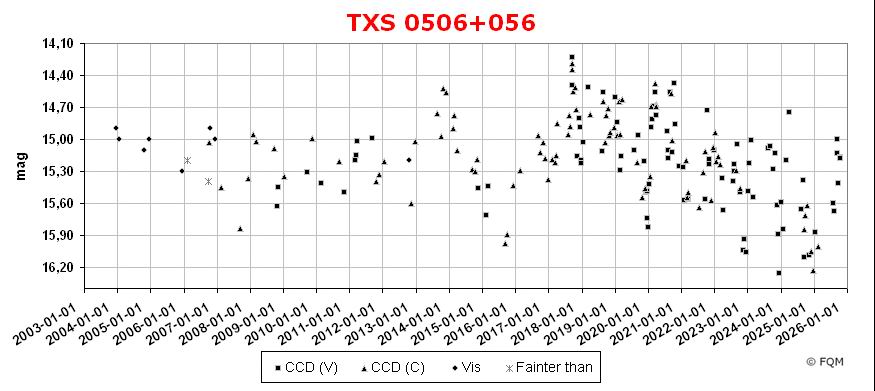
| Frankfurt Quasar Monitoring |
| TXS 0506+056 = MG 0509+0541 |
| Cross-Identifications | MG J0509+0541, TXS 0506+056, ZS 0506+056 QSO B0506+056, RX J0509.3+0541, 0506+056 2MASS J05092597+0541353, GB6 J0509+0541 87GB 050645.2+053747, 1FGL J0509.3+0540 EGR J0509+0550, 1RXS J050927.0+054145 CGRaBS J0509+0541, MG1 J050927+0541 WISE J050925.96+054135.3 |
| Equat. coordinates | RA 05 09 25.9 DE +05 41 35 (J2000) |
| Constellation | Orion |
| Type | BL Lac |
| Redshift (2) | z=0.3365 |
|
Distance
(3) (4) |
~1750 Mpc |
| Total mag range (mv) (5) | 14.23 - 16.1 |
| Catalog Magnitude (1) | 16.00 |
| Absolute Magnitude (1) | --- MB |
| Light Travel-Time (6) | 3.78 × 109 yrs |

Comparison stars
| star | B | V |
| 1 | 15.143 (0.041) | 14.495 (0.037) |
| 2 | 15.273 (0.083) |
14.649 (0.049) |
| 3 | 15.337 (0.036) |
14.926 (0.051) |
| 4 | 15.583 (0.023) | 15.032 (0.055) |
| 5 | 15.692 (0.023) | 15.241 (0.050) |
| 6 |
16.050 (0.114) | 15.364 (0.035) |
| 7 |
16.227 (0.095) | 15.824 (0.056) |


| TXS 0506+056 = MG
0509+0541 is a variable BL Lac object in Orion, roughly 4° W of
Bellatrix (Gam Ori). The
designation TXS 0506+056
refers to the Texas Survey of Radiosources (TXS), where this object was discovered as a radio source in the period 1975-1981. The other designation, MG 0509+0541, stands for the MIT-Green Bank 5 GHz Survey (MG). During this radio survey the object was again detected in 1981-82, but furthermore the stellar optical counterpart could be identified on POSS plates with a magnitude of B=16.0 and R=15.5, respectively. Today, TXS 0506+056 is classified as a BL Lac object due to its (nearly) featureless spectrum. It took until 2018, when the first redshift could be determined based on very weak emission lines, detected with the 10.4-metre Gran Telescopio Canarias. TXS 0506+056 attracted attention in September 2017, when a high-energy neutrino was detected by IceCube, designated IceCube-170922A. The arrival direction of this 290 TeV neutrino (!) was consistent with the location of gamma-ray blazar TXS 0506+056 = MG 0509+0541, observed to be in a flaring state (see light curve above) with enhanced gamma-ray activity in the GeV range. As for most BL Lac objects, this source was found to be rapidly variable in the optical by nearly 2 magnitudes, ranging between 14.2 - 16.1 mag. During bright state, visual observers may observe this blazar with telescopes of 8- to 10-inch of aperture. The object appears stellar even with large apertures. CCD observers, as well as visual observers, shall use the comparison stars given above. ____________
TXS 0506+056 is located in eastern Orion, only about 4° W of Bellatrix
(Gamma Ori). The constellation Orion is well known for its spectacular
nebula landscapes, like the Great Orion Nebula M42/43 (12° SE), the
Horse Head Nebula B33/IC 434 (11° SE) and the Flame Nebula NGC 2024
(11° SE), just to mention the most popular ones. A more challenging deep sky object is another quasar, PKS 0405-12, a bright 14-mag stellar object at a distance of more than 5×109 light-years, located some 23° SW in Eridanus. |
| Amirkhanyan, V.R., Gorshkov, A.G., et al. 1992, SvA, 36, 115; Complete Sample of Radio Sources at 3.9, 4.8, 7.5, and 11.2 GHz from the Zelenchuk Survey. Beasley, A.J., Gordon, D., et al. 2002, ApJS, 141, 13; The VLBA Calibrator Survey - VCS1. Chavushyan, V., Mujica, R., et al. 2001, Arep, 45, 79; Radio and Optical Spectra of Objects from Two Complete Samples of Radio Sources. Douglas, J.N., Bash, F.N. et al. 1996, AJ 111, 1945; The Texas Survey of Radio Sources Covering -35.5 degrees < declination < 71.5 degrees at 365 MHz. Halpern, J.P., Eracleous, M., Mattox, J.R. 2003, AJ, 125, 572; Redshifts of Candidate Gamma-Ray Blazars. Karge, S.; Helle Quasare für 8- bis 10-Zoll Teleskope. Ein Beobachtungsführer zur visuellen Beobachtung von Quasaren und BL Lacertae Objekten; Frankfurt 2005. Keivani, A., et al. 2018, ApJ 864, 84; A Multimessenger Picture of the Flaring Blazar TXS 0506+056: Implications for High-energy Neutrino Emission and Cosmic-Ray Acceleration. Lawrence, C.R., Bennett, C.L., et al. 1986, ApJS, 61, 105; 5 GHz Radio Structure and Optical Identifications of Sources from the MG Survey. II - Maps and Finding Charts. Paiano, S., et al. 2018, ApJ 854L, 32P; The Redshift of the BL Lac Object TXS 0506+056. The IceCube Collaboration et al. 2018, Science 361, eeat1378; Multimessenger Observations of a Flaring Blazar Coincident with High-Energy Neutrino IceCube-170922A. Véron-Cetty, M.-P., Véron, P. 2001, A&A 374, 92; A Catalogue of Quasars and Active Nuclei: 10th edition. Véron-Cetty, M.-P., Véron, P. 2003, A&A 412, 399; A Catalogue of Quasars and Active Nuclei: 11th edition. Véron-Cetty, M.-P., Véron, P. 2006, A&A 455, 776; A Catalogue of Quasars and Active Nuclei: 12th edition. Véron-Cetty, M.-P., Véron, P. 2010, A&A 518, 10; A Catalogue of Quasars and Active Nuclei: 13th edition. |
| home |